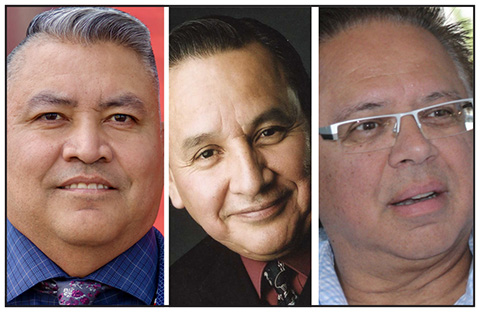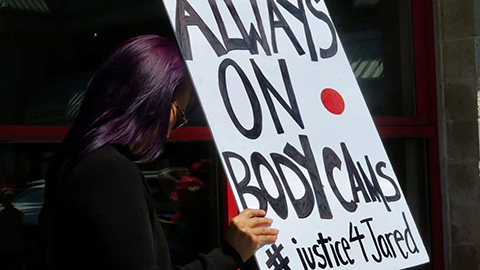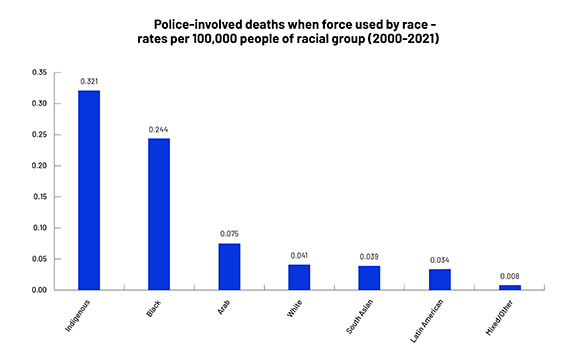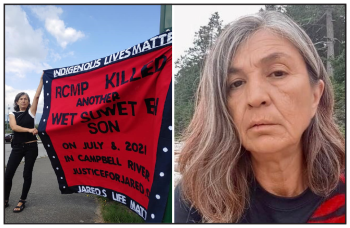Image Caption
Windspeaker.com
Updated May 13 with a statement from the Gitanyow Hereditary Chiefs.
The BC Prosecution Service (BCPS) decided April 23 not to approve charges against three RCMP members in the July 8, 2021 ‘fatal shooting’ of Jared “Jay” Lowndes, a 38-year-old father of two, and member of the Laksilyu Clan, Wet’suwet’en.
“Shame on the BC Prosecution Service and shame on the RCMP for this grave injustice,” said Grand Chief Stewart Phillip, president of the Union of BC Indian Chiefs.
The BCPS “must stop blindly sanctioning the use of deadly force against Indigenous citizens in BC. First Nations cannot continue to live in fear of RCMP officers unfettered actions that have no consequence,” Phillip said.
The Independent Investigations Office of British Columbia (IIO) investigated the actions of officers involved. On Dec. 1, 2022, the IIO’s Chief Civilian Director Ronald J. MacDonald recommended charges against three officers from the Campbell River detachment on Vancouver Island, including a dog master who put a police dog into the car with Lowndes as RCMP attempted to arrest him.
In an interview with Windspeaker, Alunaye Laura Holland, Lowndes’ mother said “It appears that the Crown (BCPS) is saying the IIO doesn’t know what they are talking about.”
After the BCPS announcement, the First Nations Leadership Council issued a statement saying it was “shocked and angered” at the result of the “closed-door” investigation.
The decision in the shooting of Lowndes came on the heels of a BCPS decision against charges in another Indigenous man’s death at the hands of police. In early April, the BCPS stayed manslaughter charges against officers in Prince George for the death of Dale Culver, (Gitxsan and Wet’suwet’en Nations), a father of three.
BCPS decisions “uphold instead of dismantle the colonial and racist institution of the RCMP,” said Assembly of First Nations Regional Chief Terry Teegee.

“It is time we had a look at the archaic, racist policies, procedures and laws that are upheld by the BCPS and law enforcement that maim, injure and kill Indigenous people in BC and Canada,” said Holland.
With its decision in the Lowndes killing, BCPS put out what it described as a “clear statement” of what happened on July 8, 2021 when RCMP attempted to arrest the man that won’t be tested before a court, said critical criminologist Jeff Shantz, despite the IIO’s contention that "reasonable grounds exist to believe that three officers may have committed offences in relation to various uses of force.”
Shantz was in the room when the BCPS delivered its decision to family and supporters. He said he observed several instances “where it was quite clear that the Crown had internalized policing assumptions.” He said that was illustrated by the Crown’s approach, “looking at things assuming police actions and assuming reasoning for police actions.”
A police dog was released into the car where Lowndes was with his own dog, surrounded by police cars.
Shantz says what’s “really troubling” was the use of the police dog “against what their procedures (are). The deployment of the dog was counter to what we know their practice is supposed to be.”
Holland said “[BCPS] actually said deploying the dog when they did is not a crime, because they are not trained to not do that.”
“They made statements to the effect that the dog handler has discretion, said Shantz. “But (BCPS) also said that they would understand or assume that the training is appropriate, that police have proper training. And I think that's a huge assumption to make, right?”
“We don't have any sort of external independent assessment to draw on about how decent or how lousy police training is,” said Shantz.
“It’s really disturbing to take for granted that police training was proper and effective, because when we look at coroners’ inquests, the recommendations are almost always for some changes to training. When cops kill, it's probably the most secretive and hidden aspect of social violence,” said Shantz.
While civilian’s names, histories, previous acts are part of court proceedings, this doesn’t happen with police, he said. “These things are never put on the stand for public scrutiny. And so a Crown can make a whole range of assumptions about policing and police acting appropriately. But those never get tested in court, which they would if it was a civilian.”
Lowndes’ family and supporters waited an “agonizing 1,020 days for this decision,” said Holland.
“It was a tempered hope,” said Shantz. “The hope is there because it would be the right and just thing within the limited confines of our rotten criminal justice system. Tempered because it happens so rarely,” he said.
“There are virtually never charges brought against cops. And even in those very few instances where charges get brought, as we saw in the Dale Culver case, for one reason or another they end up being dropped before they go to trial,” Shantz said.
“Every step of the way, I’ve had to fight,” said Holland, including a battle with the IIO to release her son’s clothes for ceremony.
“To hold those clothes. To hold police and government accountable. That fight won’t stop today.”
“I think we should be clear that the Crown and the police are part of the same system. They work together. They benefit each other in cases against civilians,” said Shantz.
In an email to Windspeaker, Chief Civilian Director MacDonald says, “The IIO will be asking the Minister of Justice to review how IIO cases are being handled by the BCPS.”
Holland and her supporters criticize Section 25 of the Criminal Code, which allows police to use force. Section 25 basically says that if the cops feel scared, they can kill,” explained Shantz.
(Section 25 (4) (d) reads the peace officer or other person using the force believes on reasonable grounds that the force is necessary for the purpose of protecting the peace officer, the person lawfully assisting the peace officer or any other person from imminent or future death or grievous bodily harm.
“Section 25 is the get out of jail free card for cops. The Crown is using it every time.” Shantz said police killings will not be charged until Section 25 is challenged and removed.

Holland calls for independent community-based oversight and a reform of the current system to ensure accountability for police violence. This includes scrutiny of the Crown and processes.
“Looking at Crown histories, looking at Crown relationships, those of us who are doing either critical criminological work or community advocacy work need to start pushing on the limitations and failings of the Crown when it comes to police violence,” Shantz said.
“We cannot accept these decisions as the status quo,” said Chief Teegee. He calls for an immediate review of the criminal justice system “in full partnership with the rights and title holders of British Columbia.”
Canada abolished the death penalty in 1976. No Canadian court can sentence someone to death, no matter what crime or how much evidence.
“Yet the police today seem to believe that they can avoid the courts and trial and simply kill a First Nations person before that person is even arrested,” said Hugh Braker of the Tseshaht First Nation. He is a lawyer and member of the First Nations Leadership Council.
“Had Mr. Lowndes been arrested and convicted, he probably would have received a prison sentence of a year or two. Instead, the police gave him death. The abolishment of the death penalty must apply to the police also,” Braker said.
“For too long, the BCPS has been permitted to hide behind these unjust policies, procedures, and laws to protect the police officers who commit crimes, inflicting pain and punishment on Indigenous people,” said Holland.
“It is time for transformative change. Enough is enough. Both these systems must be held accountable before any acts of reconciliation are possible. The truth must be heard,” she said.
“The waiting game was sometimes too much. But now I know what to do. I organized for the National Inquiry for Missing and Murdered Indigenous Women and Girls. I know the work that needs to be done. I can do it again.”
She said the path is clear to her now.
“I will move forward with the civil suit, and work alongside others to have an inquiry into killings of Indigenous people by law enforcement.”
Said Teegee, “We cannot let yet another death of our family members mark the continued inaction and failure of a system we never consented to.”
The Gitanyow Hereditary Chiefs released a statement May 10 joining in the call for a public inquiry into RCMP deaths of Indigenous Peoples.
“The message is clear, First Nations lives are disposable,” says Joel Starlund/Sk’a’nism Tsa ‘Win’Giit, executive director of the Gitanyow Hereditary Chiefs.
“We have faced potent racism and injustice at the hands of the RCMP since its creation. The history of systemic oppression is deeply ingrained with numerous instances of violence and discrimination perpetuated against Indigenous people.”

Shielded from accountability
Systemic racism in policing leads to disturbing rates of death and injury of Indigenous people in police custody. In BC there have been at least 22 police-involved deaths of Indigenous people, based on data compiled by Tracking (In)Justice.
The tracking project shows the number of people being killed in “use of force interactions” with police is increasing. In 2022, a record was set with 69 people dying during police use of force interactions, the most deaths in 20 years. The same data shows that Indigenous people die at almost eight times the rate compared to white people.
The same national database reports a 66.5 per cent increase in deaths from police violence in the past 10-year period, with a striking increase in the past five years.
"It is all too rare that there is even minimal accountability for police officers who kill in Canada,” said Shantz, who has been researching and tracking police violence in BC.
Braker said Crown’s decision to not lay charges “casts doubt on the BC Solicitor General’s Ministry and Attorney General’s Ministry support for, or faith in, the IIO.”
“The IIO was formed to ‘independently’ examine police officers’ actions and, where necessary, recommend charges. They recommended charges here,” Braker said.
Shantz said that since the inception of the IIO in 2012 to early 2023, 220 deaths were investigated. Only 14 of those resulted in recommending charges to be laid.
“Even worse is the record of the Crown in BC,” Shantz said.
“They have only actually taken one case to trial so far, declining charges in almost every case the IIO has brought to them,” Shantz explained.
“We know that prosecutors develop close relationships with and become dependent on police. This must change,” said Shantz.
Windspeaker reached out to the BCPS for an interview and received an email response. BCPS says they are “working within its mandate to meet the standards set by the UNDRIP and the TRC’s justice-related Calls to Action, all in alignment with the Draft Principles that Guide the Province of BC’s Relationship with Indigenous Peoples.” (UNDRIP is the United Nations Declaration on the Rights of Indigenous People and the TRC is the Truth and Reconciliation Commission, which released 94 Calls to Action after its investigation into the legacy of the residential school system.)
Justiceforjared.org demands body cameras that are always-on and the end of the use of police dogs. Holland wants a transformed IIO, which she says would require Indigenous oversight and investigators and removing former police from the organization to create a “truly independent investigative office.”
The BCPS said in its email to Windspeaker its team didn’t know the specific officers involved, “In accordance with BCPS policy, the charge assessment in this case was conducted by an experienced Crown Counsel with no prior or current connection with the officers.”
However, BCPS declined to provide information on how many of their counsel have previous ties to police, or are police trained.
They also declined to share how much, or if there is any Indigenous representation, saying “we cannot provide you with information about BCPS employee backgrounds.”
IIO communications and media contact Rebecca Whalen has previously shared information in July 2021 that stated 48 per cent of IIO’s “civilian and independent” team are from policing backgrounds. By November 2023, Whalen reported that percentage had dropped to 41 per cent.
In his inquiry into the death of Robert Dziekanski by RCMP at the Vancouver International Airport in 2007, one of Judge Thomas Braidwood’s recommendations in the Braidwood Commission states, under recommendation 8 titled Police Investigating Themselves, “I recommend that… e) No member of the IIO shall have served anywhere in Canada as a police officer.”
MacDonald, in his email to Windspeaker, said “I have made it clear previously that, as Justice Braidwood recommended in his report, all IIO cases ought to be handled by special prosecutors from outside of the BCPS for the appearance of independence.”
Braidwood’s recommendations included, “A special prosecutor appointed under the Crown Counsel Act would make charge assessment decisions and, if criminal charges were approved, would conduct the prosecution.”
Currently, the BCPS decides when they want to appoint external counsel.
“As a community, we watch these police officers defend each other, use their resources to shield themselves from accountability, and cover up their crimes,” said Mabel Nipshank (Cree), a matriarch close to the Lowndes family.
“We, as mothers, come into this fight with our heart and we are armed with words of our truth. We all know what the truth is—even the police know it—regardless of whether it ever surfaces in public,” Nipshank said.

